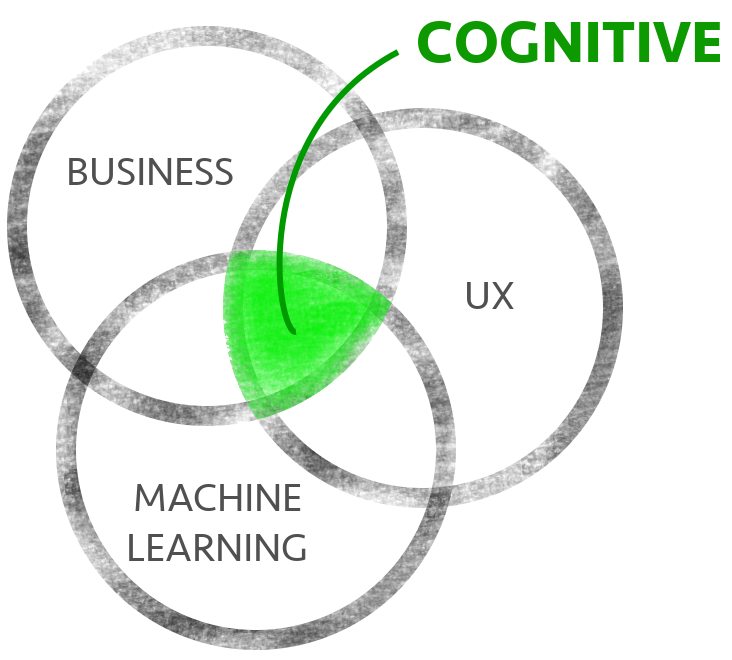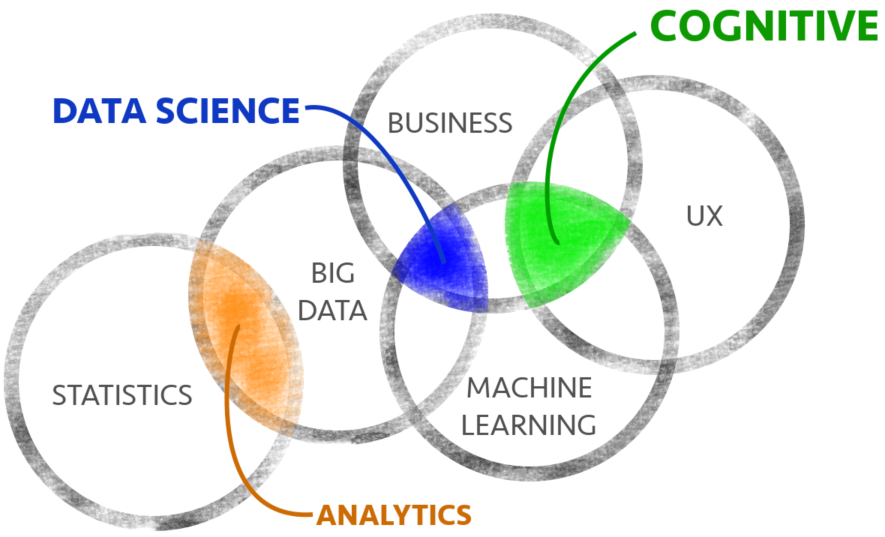Cognitive: What it is and Why you should be doing it already
[Note: This article was originally published on LinkedIn on July 27th, 2018.]
If you ask ten people, you’ll get eleven different answers. With so much hype around Cognitive, Machine Learning, AI, Deep Learning, Predictive Analytics, Data Science, etc., it has become difficult to take a stand on what cognitive is and why we should already be applying it everywhere. This positioning is critical especially for Executives, Digital Strategists, Experience Designers, Business Leaders and Developers alike, to have a clear vision around those areas and understand how they impact their day-to-day.
As everybody loves Venn diagrams, you can quickly position Cognitive like this:

Cognitive is the ability to offer a proactive experience for the user within a business context, through Machine Learning techniques. It’s a personalized response in anticipation to a user’s need or intent. It goes beyond presenting information or functionality in an intuitive and efficient way for the user — it anticipates their needs and intents and proactively satisfy them.
Among the various definitions for Cognitive, you will hear many that would be along the lines of Analytics, Predictive/Advanced Analytics, Data Science, etc. How do they all relate? One very non-scientific way to explain it easily can be an even bigger Venn diagram like this:

A key differentiation between Cognitive and Data Science/Analytics initiatives is their focus. Cognitive is customer-centric, impacting their experience proactively. Data Science/Analytics is company-centric in which improvement cycles feed on its outcomes to, perhaps, affect the user.
Cognitive can be introduced at every touchpoint in the journey. Data Science/Analytics happens after the interaction has ended.
Cognitive’s outcome is an immediate and proactive impact on the user. Data Science/Analytics’ outcomes are dashboards and reports for analysis.
Cognitive is real-time. Data Science/Analytics is based on an analysis and decision cycle.

Think about the user’s journey. Each step of this journey is a potential opportunity to transform their experience with Cognitive.
Think about what question we want to answer at every step of the journey. Perhaps to know which product the user wants to buy. Or to understand their need even before an action is taken. There is always a question. The challenge is identifying the question and be able to answer it proactively. This is a Cognitive Digital Product.
Example 1
- To know the percentage of customers that abandon a shopping cart during the month is Analytics.
- To segment customers that abandon their carts and find out the most effective approach to get those customers back through marketing is Data Science / Advanced Analytics.
- Knowing the potential of cart abandonment while a customer is still on that journey, and changing their experience to avoid it, that is Cognitive.
Example 2
- Evaluating financial products for cross-selling opportunities to an existing customer base is Analytics.
- To find a set of products with opportunity for cross-selling to offer to known segments on that customer base is Data Science / Advanced Analytics.
- To offer financial products with a high probability of cross-selling based on current and historical behavior of that user, a segment of ONE, that is Cognitive.
In a customer-centric approach, offering static experiences based on a historical view of behavior seems to fall behind on the true meaning of customer centricity. To deliver proactive and personalized experiences we need to be able to introduce cognitive in every product. And that starts by being able to explain this vision.